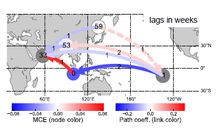Distinguishing coincidence from causality: connections in the climate system

Teleconnection between ENSO and Indian Ocean - exemplary selection of causal paths. For full info, see Figure 3 in the paper.
The method now published in Nature Communications can be applied to assess geoengineering impacts as well as global effects of local extreme weather events, and can potentially also be applied to the diffusion of disturbances in financial markets, or the human brain.
“Despite the chaos of weather you see a lot of correlations – for instance higher pressure in the East Pacific is often followed by lower pressure in the Indian Monsoon region,” says lead-author Jakob Runge of the Potsdam Institute for Climate Impact Research (PIK).
“However, if you take a closer look, you find that many correlations are simply due to another process driving both regions, an important example being the solar cycle. So you use elaborate statistics to reveal such spurious links, find new indirect pathways, and step by step you reconstruct a network more closely representing cause and effect.” The new tool detects where major perturbations entering the climate system have the largest global effect, and via which pathways they are conveyed.
East Pacific, Indonesia, tropical Atlantic most important
The East Pacific, Indonesia and the tropical Atlantic are the regions most important for spreading and transmitting perturbations, the scientists found. One reason is that in these regions particularly huge air masses rise high up in the atmosphere. So for instance warming in the East Pacific can disturb the Indian Monsoon, even though it is thousands of kilometers away. This can put at risk yields on which millions of small farmers and in fact large parts of the population depend.
“How to robustly distinguish coincidence from causality in complex nonlinear systems has long been a riddle,” says Jürgen Kurths, co-author and head of PIK’s Research Domain Transdisciplinary Concepts and Methods. “Conventional approaches, based on pairwise association measures, in some cases showed good results. Yet these methods are rather limited. You can compare it to multiple organ failure in the human body – a real puzzle for the doctors. We’re glad that we can now present a new approach to understanding the connections, which is the basis for ideally making the whole system more resilient.”
Article: Runge, J., Petoukhov, V., Donges, J.F., Hlinka, J., Jajcay, N. Vejmelka, M., Hartman, D., Marwan, N., Palus, M., Kurths, J. (2015): Identifying causal gateways and mediators in complex spatio-temporal systems. Nature Communications [DOI: 10.1038/NCOMMS9502]
Link to Nature Communications where the article will be published: http://www.nature.com/ncomms/index.html
Media contact:
PIK press office
Phone: +49 331 288 25 07
E-Mail: press@pik-potsdam.de
Twitter: @PIK_Climate
https://www.pik-potsdam.de/news/press-releases/distinguishing-coincidence-from-c…
Media Contact
All latest news from the category: Earth Sciences
Earth Sciences (also referred to as Geosciences), which deals with basic issues surrounding our planet, plays a vital role in the area of energy and raw materials supply.
Earth Sciences comprises subjects such as geology, geography, geological informatics, paleontology, mineralogy, petrography, crystallography, geophysics, geodesy, glaciology, cartography, photogrammetry, meteorology and seismology, early-warning systems, earthquake research and polar research.
Newest articles

First-of-its-kind study uses remote sensing to monitor plastic debris in rivers and lakes
Remote sensing creates a cost-effective solution to monitoring plastic pollution. A first-of-its-kind study from researchers at the University of Minnesota Twin Cities shows how remote sensing can help monitor and…

Laser-based artificial neuron mimics nerve cell functions at lightning speed
With a processing speed a billion times faster than nature, chip-based laser neuron could help advance AI tasks such as pattern recognition and sequence prediction. Researchers have developed a laser-based…

Optimising the processing of plastic waste
Just one look in the yellow bin reveals a colourful jumble of different types of plastic. However, the purer and more uniform plastic waste is, the easier it is to…



